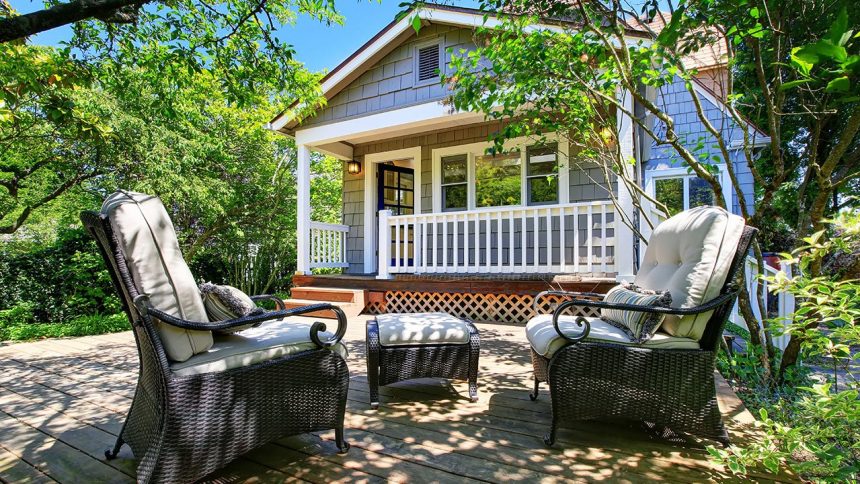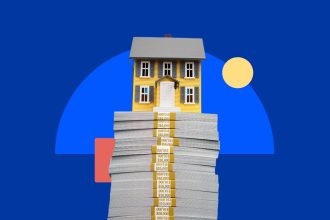Key takeaways
- An interest-only home equity line of credit (HELOC) allows borrowers to pay back just the interest on their borrowed sums during the initial draw period, typically between five and 15 years.
- An interest-only HELOC can make borrowing more affordable initially. But sticker shock can ensue when the draw period ends, and borrowers must start repaying both principal and interest.
Imagine that you had a credit card that allowed you to charge large amounts — we’re talking five, even six figures — but only required you to pay back minimal amounts each month for a decade.
A dream, right? No, that’s roughly what an interest-only HELOC is like. You specify a particular repayment plan when opening this home equity line of credit, which means that for the first several years, you only have to pay interest on the money borrowed and not the principal.
HELOCs aren’t interest-only forever, however. While this approach can make borrowing quite affordable initially, it can set you up for a shock later on, when you do have to start paying principal. So it’s important to understand what you’re signing on for.
What is an interest-only HELOC and how does it work?
A home equity line of credit, or HELOC, is a revolving line of credit secured by the equity in your home (the portion of the property you own outright, clear of your mortgage). You can borrow against this ownership stake, to fund home improvements, pay bills or even make investments. Because HELOCs are secured (backed) by your home, they typically offer lower interest rates than other forms of financing.
The HELOC has a revolving balance, like a credit card; but unlike a credit card, it doesn’t exist indefinitely – it has a set timespan, like a regular loan. “Interest-only HELOC” is essentially a phrase that refers to the line of credit during its first several years. This phase is called the draw period — you’re free to take funds from the line of credit and simply make interest-only payments in return. The draw period is normally five, 10 or 15 years, with 10 being the most common.
When the draw period ends, the HELOC repayment period begins and continues for, typically, 10 to 20 years more. You can no longer borrow money; instead, you have to repay what you owe, as on a mortgage. The minimum monthly payment then includes principal and interest, and the payments are large enough to cover the remaining interest and pay off the loan by the end of the loan term.
How does an interest-only HELOC work?
With an interest-only HELOC, you’ll push off making payments on your principal until after your draw period expires. All you’ll be paying is the interest. To calculate your monthly payment, use this formula:
[Current HELOC balance] x [annual interest rate charged on loan] ÷ 12
Let’s say you’ve drawn $15,000 against your credit line, and your annualized interest rate is 8 percent. Your regular HELOC interest-only payment would be $100 a month ($15,000 x .08 ÷ 12).
But all good things come to an end. If you have an interest-only home equity line of credit with a 20-year term and a 10-year draw, for example, then the loan becomes self-amortizing after 10 years. Over the remaining 10-year repayment period, you can no longer draw against the line of credit, only make repayments.
What’s the difference between a traditional HELOC and an interest-only HELOC?
Essentially, they are pretty much the same now. Interest-only is becoming a standard feature of home equity lines of credit.
It wasn’t always so. Originally, HELOC repayments during the draw period included both principal and interest — as mortgages and other loans do. Nowadays, there are still some of these “traditional” HELOCs left, whose payments encompass both principal and interest right from the start. Their lenders don’t like the interest-only concept, or they may limit the option to borrowers with stronger credit profiles.
But these are getting less common. Most HELOCs are, or can be, “interest-only” during the draw period: They give the borrower the option of making a payment that only covers the interest on the withdrawn funds — not unlike the minimum monthly payment on a credit card. Of course, you can always pay more, and many personal finance advisors think you should: to avoid overspending, to keep the debt manageable, and to avoid the sticker shock of combined principal and interest repayments when the draw period ends.
Pros and cons of an interest-only HELOC
There are benefits and drawbacks to using these lines of credit.
Pros
- Initial lower payments: Initially, your monthly payments are lower since you’re only covering the interest, not both the principal and interest.
- Flexible borrowing: You take out as much or as little as needed during your draw period. And repay as much or as little as you want.
- Cost-effective financing: Interest rates on an interest-only HELOC could be more economical compared to those of credit cards.
- Tax benefits: You may be able to deduct the interest made on your withdrawn HELOC funds on your tax return.
Cons
- Variable rates: Your monthly payment can fluctuate based on market interest rates.
- Shorter repayment window: Opting for interest-only payments essentially shortens your repayment period.That’s why, once the draw period ends, your monthly HELOC payments must escalate significantly to settle the loan on time.
- Sticker shock: If you’ve just paid the interest-only minimums during the draw period, the new monthlies during the repayment period can be a big blow to the budget — especially if interest rates simultaneously start to rise.
- More total interest paid: If you maintain an unpaid balance, it leads to higher accumulated interest throughout the loan’s duration.
- Foreclosure risk: With any HELOC, you’re putting your home on the line. If your payments become too much to handle, whether due to rising rates or bigger bills, you could be in danger of losing your home.
When does an interest-only HELOC make sense?
Going the interest-only route with HELOCs works if you:
- are strapped now, but expect to increase your household income in the future
- have a considerable amount of home equity built up
- think interest rates are trending down long-term
- plan to move before the draw period runs out (somewhat akin to the strategy of an adjustable-rate mortgage). You’ll have to settle up when you sell, but presumably your proceeds will cover the balance due.
When should you avoid taking out an interest-only HELOC?
An interest-only HELOC won’t make sense in some situations and could even be a risky decision if you are not financially prepared for the repayment structure. Here are some of the scenarios in which an interest-only HELOC may not be right for you.
Limited home equity
If you don’t have a lot of equity in your home, it won’t be an option for you. Any type of HELOC is primarily dependent on your home’s equity. Percentages vary by lender, but most will only let you borrow up to 80 or 90 percent of your home’s value.
Low credit score
Remember this financing mantra: The higher your credit score, the lower your interest rate. HELOC lenders save their best offers for those with scores in the “very good” and up range. You may still be able to get a home equity line of credit with less-than-perfect credit, but interest rates will be higher. This means that you’ll have to pay hundreds, if not thousands of dollars more, throughout the loan term.
Can you open an interest-only HELOC with bad credit?
Securing an interest-only HELOC might be challenging with a lower credit score. Many lenders will allow you to tap into your home’s equity with a “fair” credit score hovering in the mid-600s — even as low as 620. Certain lenders may even offer an interest-only HELOC to those with scores below 620 — though they might demand a bigger equity stake or lower debt-to-income ratios.
In any event, HELOCs for individuals with poor credit would entail higher interest rates, restricted loan amounts and abbreviated repayment terms.
Repayment concerns
You should also avoid an interest-only HELOC if you aren’t confident you can make larger payments once the repayment period arrives or if the interest rate — which is variable — rises. Know how long your loan’s draw period is and make plans for how you’ll continue paying off the HELOC once your monthly payment increases. This might be several years down the line, depending on the terms of your HELOC, and requires careful financial planning.
What are alternatives to an interest-only HELOC?
Not everyone is comfortable taking out a HELOC, even if they can. Here are some alternatives.
Home equity loan
A home equity loan is similar to a HELOC in that you are borrowing against the equity in your house. But instead of getting a line of credit that you can reuse as you repay it, you get a lump sum. Your rate is fixed and so are your monthly payments. Rates on home equity loans tend to be a little lower than they are for HELOCs.
Good for: You know how much money you need, and you’d like to get it all at once.
Avoid if: You think you’ll need to tap into your home equity multiple times, and/or aren’t sure of how much you’ll ultimately need to spend.
Personal loan
You can take out a personal loan from your bank or credit union or an online lender. Your credit score largely determines what your interest rate will be. If you can get a loan with a low interest rate, it can be a good alternative to hocking your house. If the interest rate on your personal loan is much higher than the rate you could get with a HELOC, a personal loan might not be a great option.
Good for: You have good credit (but not much home equity) and need funds quickly.
Avoid if: Your credit could use improvement, or you’d like a decades-long repayment term.
Credit cards
Credit cards can be a fast way to get the funds you need without dipping into your home’s equity. Many cards have 0 percent interest on purchases or balance transfers for a set period, which is great if you have a big expense coming up or need to pay off some debt. But be careful—once that intro period ends, the interest rates can jump, making it a pricey option if you can’t pay off the balance quickly.
Good for: When you need quick access to cash, plan to pay it off soon, and can snag a zero percent introductory rate.
Avoid if: You think you might carry a balance for a while, as credit cards’ double-digit interest rates can add up fast, making your debt mushroom.
Cash-out refinance
A cash-out refinance replaces your current mortgage with another, larger one; you receive the difference in a lump sum. As with the HELOC, the amount of extra cash is based on your equity stake in your home. Refinancing rates are often comparable to primary mortgage rates, and lower than those of home equity loans and HELOCs. And if you’re refinancing at a lower interest rate than on your current mortgage, your monthly payments may even drop.
Good for: You have at least 20 percent equity in your home, and your current mortgage rate is higher than today’s average rates. Also, you like the idea of having a single large debt to repay (vs. having a mortgage and a home equity loan or HELOC).
Avoid if: You got your mortgage when rates were low, and refinancing would result in a substantially higher rate. Or you can’t afford closing costs on another loan/don’t want the hassle of going through the whole mortgage application process again.
Bankrate’s take: If your aim is simply to have more available money each month (not a big upfront sum), you could also consider a straightforward rate-and-term mortgage refinance, in which you simply swap your current home loan for one of the same size, but with a better rate or payment terms. Just keep in mind that — unless you get a substantially shorter loan — you’ll be extending the number of years you’ll be making mortgage payments, and probably paying more in interest overall.
What should I do when my HELOC draw period ends?
Here’s a step-by-step guide for what to do when your HELOC draw period is ending:
A few months before your HELOC draw period ends, look at the balance on your line of credit. Determine how much your monthly payments will be and how you’ll need to adjust your budget to account for that.
Once your draw period ends, update your monthly payment to the new amount.
If the new (higher) monthly payment is a financial burden, it’s better to reach out to your lender than to stop making payments. Your lender may offer options like increasing the amortization length, which will lower the monthly payment.
You could also consider refinancing the HELOC itself.
The bottom line on interest-only HELOCs
During the initial draw period of an interest-only HELOC, your monthly payments are relatively low because you’re only paying interest. Once your HELOC draw period ends, you’ll be required to start paying down the principal as well. This means that your monthly payments will go up, possibly significantly.
An interest-only HELOC can make borrowing more affordable initially. But remember, those minimal payments don’t last forever. When the draw period ends, you will be responsible for repaying principal and interest. Before proceeding, be sure your budget can accommodate this type of repayment plan.
Read the full article here














